A new management plan began in the summer of 2017. In order to control cattails, aerial spraying was conducted with herbicide approved for use over water, and dead cattail thatch was subsequently mowed down. This took place over ~300 acres in the eastern portion of the marsh-pool complex. Spraying and mowing will be done later this year for the western side of the marsh-pool area (see below).
    |
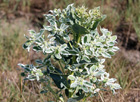
| Snow-on-the-mountain (Euphorbia marginata, KWG). This plant typically blooms in late summer, and when broken it releases a toxic sap with effects similar to poison ivy. It is considered weedy or invasive (USDA). Left: distinctive white-and-green leaves that surround small flowers. Right: wasp on the plant. |  |
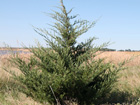
| Small trees growing in the farther reaches of TNC marsh area not subject to aerial spraying. Left: eastern redcedar (Juniperus virginiana, USDA). Right: willow (Salix L., USDA). Neither is desirable in this prairie marsh situation. | 
|
Return to beginning.
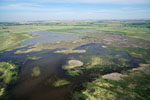 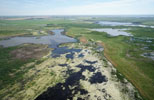 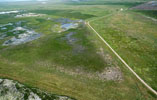 |
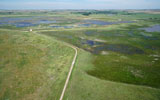 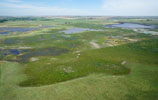 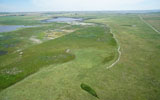 |
Return to beginning.
We conducted kite aerial photography from the nature trail site next to the observation tower. The impact of aquicide spraying in 2018 was still quite evident with extensive patches of dead cattail thatch in the water-filled pools. What surprised us, however, was the spread of duckweed throughout the thatch areas. As seen from above the duckweed creates a bright yellow-green surface. Common duckweed (Lemna minor) resembles split green peas. It is the smallest and simplest of all flowering plants and is also one of the most common plants worldwide. Duckweed is an important food resource for birds and other wetland wildlife.

| Closer views of marsh looking toward the north (left) and west (right). The bright yellow-green areas are duckweed covering the water surface in areas of cattail thatch. | 
|
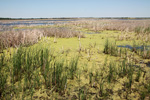
| Left: live cattail in foreground and dead thatch in background with duckweed on water surface. Right: close-up view of duckweed covering water surface in thatch area. | 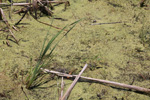 |
    |
Areas of aerial spraying in 2017, 2018, and 2019 were quite evident especially for mudflats. Mudflats just above water level and still moist have a gray appearance; whereas, slightly higher and drier mudflats were covered with a lime crust and appear light gray to almost white.
![]()
![]() Return to beginning.
Return to beginning.
Continue to 2021 – 2022.
Return to Cheyenne Bottoms homepage.
All rights reserved © (2020).